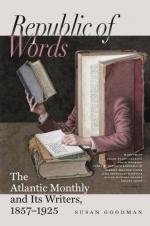Or, if one tire of the open meadows, and the sun be too hot, think of the laurel groves,—not now, as in the Christmas-time, white with snow, but white again with thousands on thousands of argent cups, loaded with blossoms, meeting over your head in arches of flowery tracery, and one solitary tree standing deep in the woods, like a frigate packed with her silver canvas lying out to windward of the fleet of merchantmen she is convoying. The cool laurel groves! Often as one sees that sight, it is always with a fresh shock of pleasure to the frame.
Then, when autumn comes and the leaves change, there is still endless variety for the little basket or botanical-case which swings lightly on your arm or hangs across your shoulder. Owen Jones never devised any ornaments for wall or niche one half so brilliant as the color of those leaves which a dexterous hand will readily group upon a sheet of white paper, where your eye may catch it, as, after achieving a successful sentence, you look up from your study-table. Speaking of leaves, who knows how large an oak-loaf will grow in this New England? I have just sat down after measuring one gathered in a bit of copse hard by the town of M——, a bit of copse which skirts a beautiful wild ravine, with a superb hemlock and pine grove creeping down its steep bank. I have just honestly measured my leaf, and it shows fourteen inches in length by a trifle of nine and a half in breadth.
In the same ravine I found—and in any patch of woodland you may do the like—a perfect treasury of mosses. A shallow tin box or a wooden bowl filled with these and duly watered will give a winter-garden to the smallest lodging. Sun and light are, as Mr. Toots says, of “no consequence” to the moss family. But if one be above such trifles as mosses, and with Young American loftiness aspire to full-grown trees, there is still plenty to do in the most ordinary woodlands. After a chapter of Mr. Ruskin upon Claude and Poussin and Turner, there is nothing like going to the original documents. In default of the National Gallery from London and the Pitti Palace from the other side of Arno, which cannot be summoned into court at a moment’s notice, we can solve at least half the problem. Mr. Ruskin may or may not be right about the Claudes; but it is very easy to see if he be right as to the trees. And if we prove him right with his theory of branches and bark, we have a fair presumption that he has eyes to see the alleged falsehoods in him of Lorraine. Now here is a chance to do a little bit of Art-criticism quite unexpensively. Discontented young gentlemen murmur about the education of this people being too practical, unaesthetic, and all that, and sigh for the culture which a foreign land only can give. But a man who has no eye for Nature will hardly learn to love her at second-hand through the mediation of canvas and colors. I should like very much to be able to walk into a Turner Gallery once a week;




